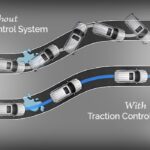Driving safely means being aware of your surroundings and making smart decisions to prevent accidents. One crucial aspect of safe driving is maintaining a proper following distance. We’ve all experienced the discomfort of a car tailgating us, but understanding exactly how much space to leave can be confusing. While the idea of car lengths is often discussed, a more precise and reliable method exists to ensure your safety on the road.
The 3-Second Rule: Your Guide to Safe Spacing
Instead of relying on potentially inaccurate estimations of car lengths, safety experts recommend the three-second rule. This simple technique helps you maintain a safe buffer zone between your vehicle and the one in front of you, regardless of your speed.
Here’s how it works:
- Pick a stationary object: As the vehicle ahead of you passes a fixed point on the side of the road – like a signpost, tree, or overpass – choose this as your marker.
- Count “one-thousand-one, one-thousand-two, one-thousand-three”: Begin counting as soon as the rear of the car in front of you passes your chosen marker.
- Check your position: If you reach the same marker before you finish counting “one-thousand-three,” you are following too closely. Slow down and increase your following distance until you can comfortably count to three before reaching the marker.
This three-second rule provides a minimum safe following distance in ideal conditions.
Why Seconds Are Better Than Car Lengths
While thinking in terms of “car lengths” might seem intuitive, it’s inherently flawed for several reasons:
- Varying Vehicle Lengths: Cars come in all shapes and sizes. A car length can vary significantly between a compact car and a large SUV or truck. What might seem like a safe distance in car lengths could be dangerously short depending on the vehicles involved.
- Speed Changes Everything: The faster you drive, the more distance you need to stop safely. A fixed number of car lengths becomes increasingly inadequate at higher speeds. The three-second rule automatically adjusts for speed, providing you with greater physical distance as your speed increases.
- Reaction Time: The three-second rule accounts for average driver reaction time. In an emergency braking situation, those few seconds can be the difference between a safe stop and a collision.
The Critical Importance of Following Distance
Rear-end collisions are a leading type of car accident, and they are frequently caused by insufficient following distance. The National Highway Traffic Safety Administration (NHTSA) has found that nearly 30% of injury-causing crashes are rear-end collisions. Maintaining a safe following distance is a proactive measure to significantly reduce your risk of being involved in such an accident, whether as the follower or being rear-ended yourself.
Moreover, the three-second rule is just a minimum. You should increase your following distance in less-than-ideal conditions, such as:
- Wet or icy roads: Reduced traction requires longer stopping distances.
- Poor visibility: Fog, heavy rain, or snow limit your reaction time.
- Driving a large vehicle or towing: Larger vehicles require more distance to stop.
- When being followed closely: If you notice a vehicle tailgating you, gently increase your following distance from the car ahead to give yourself more time to react if the car behind causes you to brake suddenly. In some cases, safely changing lanes to let a tailgater pass might be the best course of action.
- Driver Distraction or Fatigue: If you are tired or distracted, increasing following distance gives you more time to react.
Defensive Driving: Space as a Safety Tool
Defensive driving is about anticipating potential hazards and taking steps to avoid them. Maintaining a proper following distance is a cornerstone of defensive driving. It gives you:
- Time to react: More space allows you to brake or maneuver safely to avoid sudden stops or hazards ahead.
- Buffer zone: A safe gap provides a buffer if the car in front of you brakes unexpectedly.
- Improved visibility: Greater distance can improve your view of the road ahead, allowing you to anticipate traffic flow and potential problems earlier.
Drive Smarter, Drive Safer
While “car lengths” is a common phrase, the three-second rule offers a more practical, adaptable, and safer method for determining your following distance. By adopting this technique and practicing defensive driving habits, you can significantly enhance your safety and confidence on the road.
To further improve your driving knowledge and skills, consider exploring resources like online driver education courses. Continuous learning is a key component of becoming a safer and more responsible driver.
